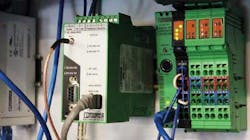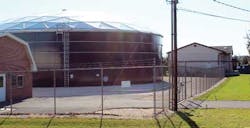The Middlesex Township Water Authority, near Carlisle, PA, provides drinking water to 3,300 customers. Due to new EPA regulations, the Water Authority needed to update its remote pump monitoring system. The new rules required the township to report its trending data for chlorine levels and turbidity more accurately, and to respond to alarms within a half hour.
Previously, the township monitored these levels manually. Personnel would travel to the sites to manually record the data and to perform regular maintenance. The staff would then upload this local trending data via USB on the hour.
Because this was a manual process, the township only had data about the chlorine levels during normal business hours. They could not run the pumps after the maintenance staff's normal shift ended. To supply water after hours, the township had to purchase water from nearby municipalities.
The township wanted to upgrade this antiquated system. A new automated SCADA system would reduce the cost of manpower/maintenance and ensure the authority always had accurate, timely information at the main control center.
Middlesex Township contracted with Control Systems 21, a system integrator in Dillsburg, PA, to implement automatic monitoring and control of its remote wells and pump stations. The solution incorporated the ILC 150 VLC programmable logic controller (PLC) from Phoenix Contact, industrial firewall routers and several different Ethernet radios, along with managed and unmanaged Ethernet switches and serial communication servers.
Corey Heckman, automation manager at Control Systems 21, cited the ILC 150's gateway capability as the keystone in the automated system. The ILC acted as a communications gateway to the system's legacy PLCs, communicating via EtherNet/IP to Modbus/TCP, then to Modbus RTU via a com server.
The new system connects different PLCs, PCs and DVRs over a wireless and VPN network. The application uses several different protocols, including EtherNet/IP, Modbus/TCP, Modbus RTU and OPC.
Steve Redcay, automation sales engineer at Phoenix Contact, explained, "The legacy PLCs had data that we needed to communicate back through a VPN tunnel. With the ILC, we were able to communicate with those PLCs and change the protocol to work better with a wireless network."
There was no Internet connection at the remote sites. Control Systems 21 installed Phoenix Contact Trusted Wireless Ethernet (TWE) radios. The application used both 400 MHz and 900 MHz versions, along with different gain antennas, depending on the specific requirements of the sites. Phoenix Contact cabling and surge protection enhanced the system's reliability.
Most of the sites were reachable via 400 MHz, 5 W radio. However, the township's size and topography presented a challenge in one location. The hilly terrain made line-of-sight impossible, so the radios could not reach the main office in one hop.
"We would have needed a 150-foot tower to overcome the topographical issues of a 400 MHz radio," Heckman said. "Another option was a cellular system, but that would have incurred monthly cellular fees."
At this location, Control Systems 21 installed Phoenix Contact's FL mGuard. The mGuard is a security device featuring firewall, router and VPN in one package. It is designed to meet the harsh conditions common in industrial applications. The mGuard created a secure VPN tunnel to communicate critical video and Ethernet data over the Internet and back to the main office.
Results
Middlesex Township now has accurate and on-time data on chlorine and well levels. According to Rory Morrison, authority manager, the water authority no longer needs to send maintenance personnel to drive to remote sites, reducing both labor and transportation costs.
"The system is better now because we don't have to spend so many man hours at the well site. We were visiting the site several times a day, turning pumps on or off. Now we can do that remotely over a laptop or cell phone," he said.
The automation has also eliminated the need to buy water from neighboring municipalities. In addition, Heckman estimates that Phoenix Contact Technical Service and local sales support saved approximately 40 hours of labor.
"The Phoenix Contact employees are very knowledgeable," he said. "They were out for technical support, and were there for the start-up. They really trained us for the project."
Ultimately, the system's faster update times and reliable communication will help Middlesex Township keep the clean water flowing and avoid EPA fines.
WaterWorld Articles Archives





